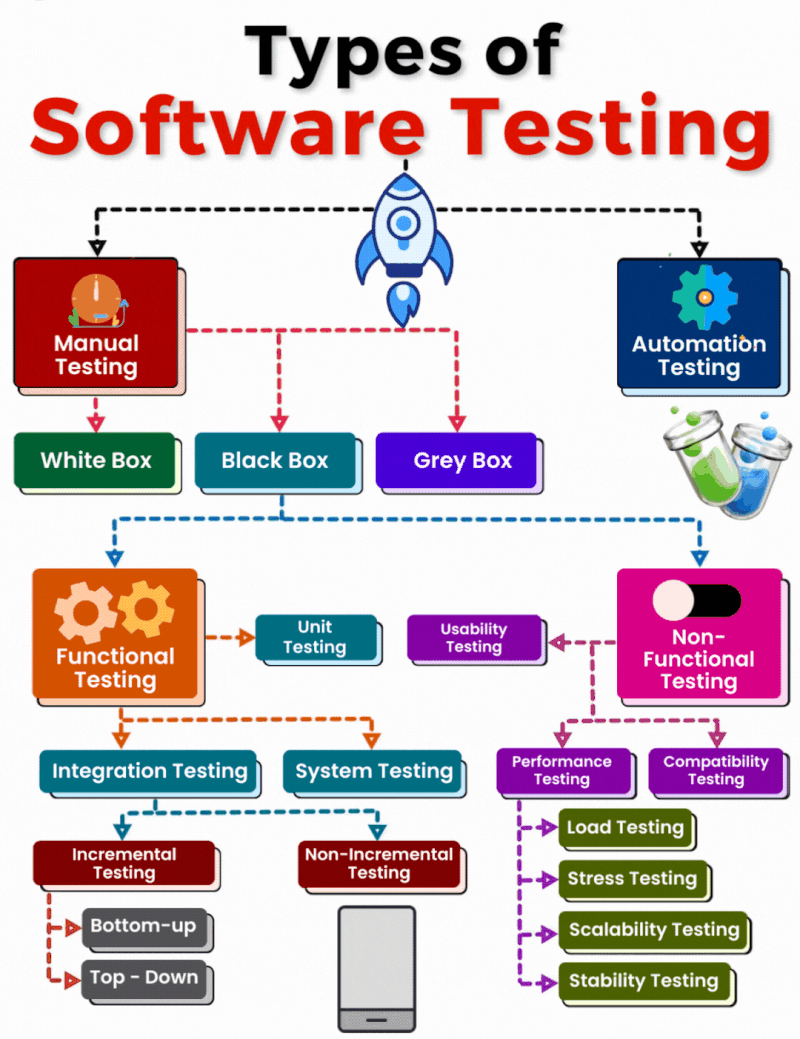
𝟭. 𝗠𝗮𝗻𝘂𝗮𝗹 𝗧𝗲𝘀𝘁𝗶𝗻𝗴
Manual testing involves human effort to identify bugs and ensure the software meets requirements. It includes:
𝐖𝐡𝐢𝐭𝐞 𝐁𝐨𝐱 𝐓𝐞𝐬𝐭𝐢𝐧𝐠: Focuses on the internal structure and logic of the code.
𝐁𝐥𝐚𝐜𝐤 𝐁𝐨𝐱 𝐓𝐞𝐬𝐭𝐢𝐧𝐠: Concentrates on the functionality without knowledge of the internal code.
𝐆𝐫𝐞𝐲 𝐁𝐨𝐱 𝐓𝐞𝐬𝐭𝐢𝐧𝐠: Combines both White Box and Black Box techniques, giving partial insight into the code.
𝟮. 𝗔𝘂𝘁𝗼𝗺𝗮𝘁𝗶𝗼𝗻 𝗧𝗲𝘀𝘁𝗶𝗻𝗴
Automation testing uses scripts and tools to execute tests efficiently, ensuring faster results for repetitive tasks. This approach complements manual testing by reducing time and effort.
𝟯. 𝗙𝘂𝗻𝗰𝘁𝗶𝗼𝗻𝗮𝗹 𝗧𝗲𝘀𝘁𝗶𝗻𝗴
Functional testing verifies that the application behaves as expected and satisfies functional requirements. Subtypes include:
𝐔𝐧𝐢𝐭 𝐓𝐞𝐬𝐭𝐢𝐧𝐠: Validates individual components or units of the application.
𝐔𝐬𝐚𝐛𝐢𝐥𝐢𝐭𝐲 𝐓𝐞𝐬𝐭𝐢𝐧𝐠: Ensures the application is user-friendly and intuitive.
𝗙𝘂𝗻𝗰𝘁𝗶𝗼𝗻𝗮𝗹 𝘁𝗲𝘀𝘁𝗶𝗻𝗴 𝗳𝘂𝗿𝘁𝗵𝗲𝗿 𝗲𝘅𝘁𝗲𝗻𝗱𝘀 𝘁𝗼 :-
𝐈𝐧𝐭𝐞𝐠𝐫𝐚𝐭𝐢𝐨𝐧 𝐓𝐞𝐬𝐭𝐢𝐧𝐠: Tests the interaction between integrated modules. It has two methods:
𝗜𝗻𝗰𝗿𝗲𝗺𝗲𝗻𝘁𝗮𝗹 𝗧𝗲𝘀𝘁𝗶𝗻𝗴 :-
𝐁𝐨𝐭𝐭𝐨𝐦-𝐔𝐩 𝐀𝐩𝐩𝐫𝐨𝐚𝐜𝐡: Starts testing with lower-level modules.
𝐓𝐨𝐩-𝐃𝐨𝐰𝐧 𝐀𝐩𝐩𝐫𝐨𝐚𝐜𝐡: Begins testing with higher-level modules.
𝐍𝐨𝐧-𝐈𝐧𝐜𝐫𝐞𝐦𝐞𝐧𝐭𝐚𝐥 𝐓𝐞𝐬𝐭𝐢𝐧𝐠: Tests all modules as a single unit.
𝐒𝐲𝐬𝐭𝐞𝐦 𝐓𝐞𝐬𝐭𝐢𝐧𝐠: Tests the entire system as a whole to ensure it meets specified requirements.
𝟰. 𝗡𝗼𝗻-𝗙𝘂𝗻𝗰𝘁𝗶𝗼𝗻𝗮𝗹 𝗧𝗲𝘀𝘁𝗶𝗻𝗴
Non-functional testing evaluates the performance, reliability, scalability, and other non-functional aspects of the application. Key subtypes include:
𝗣𝗲𝗿𝗳𝗼𝗿𝗺𝗮𝗻𝗰𝗲 𝗧𝗲𝘀𝘁𝗶𝗻𝗴 :-
𝐋𝐨𝐚𝐝 𝐓𝐞𝐬𝐭𝐢𝐧𝐠: Checks the application’s behavior under expected load.
𝐒𝐭𝐫𝐞𝐬𝐬 𝐓𝐞𝐬𝐭𝐢𝐧𝐠:Tests the application’s stability under extreme conditions.
𝐒𝐜𝐚𝐥𝐚𝐛𝐢𝐥𝐢𝐭𝐲 𝐓𝐞𝐬𝐭𝐢𝐧𝐠: Assesses the application’s ability to scale up.
𝐒𝐭𝐚𝐛𝐢𝐥𝐢𝐭𝐲 𝐓𝐞𝐬𝐭𝐢𝐧𝐠:Ensures consistent performance over time.
𝐂𝐨𝐦𝐩𝐚𝐭𝐢𝐛𝐢𝐥𝐢𝐭𝐲 𝐓𝐞𝐬𝐭𝐢𝐧𝐠: Verifies that the application works across various devices, platforms, or operating systems.
𝗪𝗵𝘆 𝗦𝗼𝗳𝘁𝘄𝗮𝗿𝗲 𝗧𝗲𝘀𝘁𝗶𝗻𝗴 𝗠𝗮𝘁𝘁𝗲𝗿𝘀
Testing ensures a bug-free, reliable, and high-performing application. By combining manual and automated approaches with functional and non-functional testing techniques, developers can deliver a robust product that meets both user expectations and business requirements.
Understanding these testing types helps teams choose the right strategy to achieve software excellence!
Comments are closed